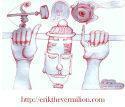Be Kind! Share with your Team, with your Family, with your Buddies!
Click The Button Now & Like This On Your Facebook Page!
Saturday, April 20, 2013
Best Forex Trade Signals Setup Process
As you can see from the video, registering to Best Forex Trade Signals and setting up to receive the signals is very simple. As part of the simple process, your account is setup to start receiving the signals through direct broker copying. In less than 20 minutes, you can start a Forex business that is run on autopilot.
Friday, April 19, 2013
Pros and Cons of Traditional and Alternative Turf Planting Methods
A bare front yard or backyard garden area need to be prepared before laying the sods. Preparations include loosening of the soil, removal of boulders and debris and adding fertilizers soil before hand. The soil should be kept moist always. Laying of sods may pose some challenges especially when the area to be worked on is sloping, uneven or is irregularly shaped like areas around tree trunks.
Sods also need to be meticulously cared for prior to and after they are laid on the soil. While waiting to be planted, they need to be kept moist to prevent withering and eventual dying. Planting of the sods should be during an ideal "window" period when the weather is not too hot, not too cold or too damp. Otherwise, the harsh weather conditions will most likely cause the sods to die.
Commercially available sod forms of turf grass are germinated in greenhouses which are controlled environments and after a while transplanted in outdoor farms or fields. The risks of being contaminated with disease-causing germs, parasites and weeds are high relatively high in these fields. Consequently, there is a chance that weeds, parasites and germs will also be transplanted in residential gardens or yards. This can eventually cause serious infestations that can potentially destroy other plants within the vicinity.
Using dry seed broadcasting method will reduce the risk of weed and parasitic infestations. Dry turf seeds also have longer shelf life which makes choosing the right date for planting easier. Unlike sods, dry turf seeds do not require constant moisture and are not at risk of withering. However, there is still the need for extensive preparation of the soil. Broadcasting dry seeds is likewise is not too precise. And because of uneven distribution and germination rate the turf grass growth may not be balanced. Erosion can pose a risk too or in case of heavy rain the seeds may be carried as runoffs. There is also the possibility that the seeds would die and decompose before they even germinate.
Hydroseeding is still another method of planting turfs that is getting increasingly popular. It is a little costlier when you speak of per square foot or square meter application. However, it is still cost-effective in the long term. It is also cost-effective in terms of labor and time that can be saved. As its name connotes, this method utilizes a slurry of mulch, turf seeds, organic coloring, fertilizer, mulch and water.
This method makes use of a slurry tank, pump, and hose. Since the slurry is highly fluid, they can be applied with greater precision. They are easier to apply on sloping and uneven terrains. They are also easy to apply on hard-to-reach areas. The mulch ensures the retention of water and nutrients. The seeds then sprout in a protected environment and with enough moisture and nutrition.
If you are interested in learning more about the topic discussed in the article, you can visit hydrospraygrass website. You can further explore this hydro-spray-grass hyperlink for other related topics.
Thursday, April 18, 2013
Important Things to Check When Buying a Used Houseboat
When you buy used houseboat, you can get many add-ons that were not originally installed. This is one of your advantages. The boat owner may have added some things and may have forgotten to take into account such things when naming his price for resale. Items like dock lines, fenders, electronics, and furnishings just to name a few. But you still have to consider some few things before you buy a used houseboat.
Written below are some tips and the vital things you need to keep in mind.
Consider first impressions. When you are looking at houseboats, give each one a quick look from the outside and in. Look for obvious things like unkempt dock area, peeled, faded, or chipped paint, mildew on the carpets. If little things like so are kept well, there's are big chance that the bigger things are not maintained well also. On the other hand, if a houseboat appears clean, this can be a good indication that the owner takes good care of his boat. The following are some outside parts of a houseboat which you have to inspect thoroughly.
a. Roof. Walk all around the roof of the boat. See if the gel coat shows signs of chipping or cracking. Also, check for signs of weak spots. Weak spots are signs of rotting wood, which can cost you a lot of money if you are to repair the roof.
b. Hull. If the boat has steel hull, look for signs of corrosion. Inspect the inside of the hull as well since many hulls can rust from the inside and out. With a flashlight, go down the hatch and check the insider of the hull. If replacement is needed, it can cost you a lot of money. For both steel and aluminum hulls, check the joint welds for signs of weakness like cracks. For fiberglass hull, look for any signs of stress cracks and blistering.
c. Paint. Take a very close look at the paint. Check if it's cracking, peeling, fading, or chipping. Another way to inspect is to take your hand and wipe it over the boat's paint. If a significant amount of paint comes off your hand, you may need to repaint it pretty soon.
d. Carpet. Carefully inspect the boat's carpet. Check if there are molds. Also, check if the corners are curling. Curling and molds are the signs for the need of replacement.
e. Canvas. Most boat buyers often overlook the canvas. You need to check the canvas for fading and wear. If the houseboat you are eyeing on has a lot of canvas, consider that replacement will cost you a lot of money.
Tuesday, April 16, 2013
Relocating Established Trees With Tree Transplanting Equipment
Tree spades were initially developed for industrial use at nurseries, however spade attachments for small dirt movers like a BobCat(TM) are available for residential use. Tree moving equipment for rent can be a affordable way for you to protect your back from the back-breaking work of tree relocation.
Utilizing a tree spade is relatively straightforward. Usually it includes 4-6 blades which can be pushed into the ground and remove a plug of soil. The dimensions of the hole is dependant on the dimensions of the tree spade.
Start by watering the location around the tree for approximately 2 days. Basically what you're doing is moistening the root ball so that the soil will stick to it. It's a plus that the ground softens too, but not the primary reason.
It's critical to become acquainted with the leavers you may be employing to maneuver the blade. If you're not currently acquainted with the equipment, ask for directions prior to employing it. It'll be safer than figuring it out as you go.
Dig the hole for the relocation before you remove the tree from its existing location. Position the open blades over the ground exactly where you wish to take away the plug of soil. Lower the blade arm. Utilizing the appropriate levers, drive the blades into the ground.
Lift the shut blades. With them will come a plug of earth which will be a conical shape that's the acceptable dimensions for tree you're relocating. (Provided you have measured correctly) Deposit the dirt alongside of the hole.
At this time before you relocate the tree, scrape the sides in the holes to loosen the dirt to permit the roots to re-establish. Don't loosen the dirt on bottom of the hole; the root ball requires a strong foot to be positioned upon. The root system grows, not down, but out from the sides of the root ball.
The process of digging up the tree is similar. However, you're not going to just pluck the tree from the ground in 1 motion, like you did with the hole.
Maneuver the tree spade so that the opened blades are equidistant around the tree trunk. Lower the blades to the ground. Close the blades and drive each blade 3 inches into the ground. Then back the blades back out about an inch or so, then drive them an additional 3-4 inches. Repeat this until the blades fully close around the root ball of the tree.
Once the root ball is securely in the spade, maneuver that tree mover over to the new location. Position the blades in the same way as they were when the plug was removed. Lower the blades into the hole and gradually open up the blades releasing the root ball so that it comes to carefully rest on the bottom.
Lift the blades back out. At this point backfill the hole creating a mound of dirt around the tree. It's best to then cover that dirt with mulch and water it promptly. The initial yr after tree transplant is critical for watering. Water it every 2 weeks extremely properly.
Thank goodness that plant nursery equipment is available to residential owners now. Tree spades makes moving trees extremely simple, will save money for home owners, and makes it feasible to redesign residential landscapes economically.
For more information about tree moving equipment you can contact Heritage Oak Farm's ProLine division at 1-888-288-5308 M-F 8-5 central time and Sat. 8-12:30 central time. You can also email us about any of our ProLine equipment info@heritageoakfarm.com
Sunday, April 14, 2013
Cloned Plants and Hydroponics Systems
Cloning plants is relatively easy compared to cloning animals. Vegetative parts of plants such as stems and leaves can be cloned given the right conditions. On the other hand, the undifferentiated and continually growing cells of plants such as those found in root tips are also ideal for cloning. By adding certain types of hormones such as auxins, the mature plant cells can be triggered to become undifferentiated and develop into new genetically identical plants. Removing a plant callus or undifferentiated part and planting it directly on a growth media is the simplest method of cloning a plant. Many species of plants such as cassava can easily be cloned by cutting their stems and planting them directly in the ground. It may take several days or a few weeks before new plant seedlings become viable. Newly formed but genetically identical plants will eventually grow.
However, it should be noted that not all species of plants are easy to clone. Some require special processes and careful attention. Some plants that have high agricultural and horticultural value oftentimes need special care and attention. Agriculturists and horticulturists value plants that have high crop yields, high resistance to disease, and have excellent aesthetic appeal. Many of the highly desirable plants are rare and do not easily reproduce. More often than not, the only effective way of reproducing these plants is through the process of cloning. Hydroponic systems can provide the ideal conditions for cultivating these cloned plants.
Using hydroponic systems is the ideal way of cultivating plants indoor. Cloned plants typically need precise amount of water, nutrients, and hormones that can be calibrated using hydroponic systems. Some varieties of plants require very meticulous care in order for them to develop. Another main advantage of hydroponic systems is that they can be set up in such a way that the growth media can be made sterile, preventing plant infections. The growth and development can be precisely controlled and monitored. The consumption of water and nutrients is very efficient when it comes to hydroponic systems.
If you want to learn additional information related to the topic discussed in the article, you can follow this cxhydroponics hyperlink. On the other hand, you can also explore further by visiting this hydroponic system blog post link.















